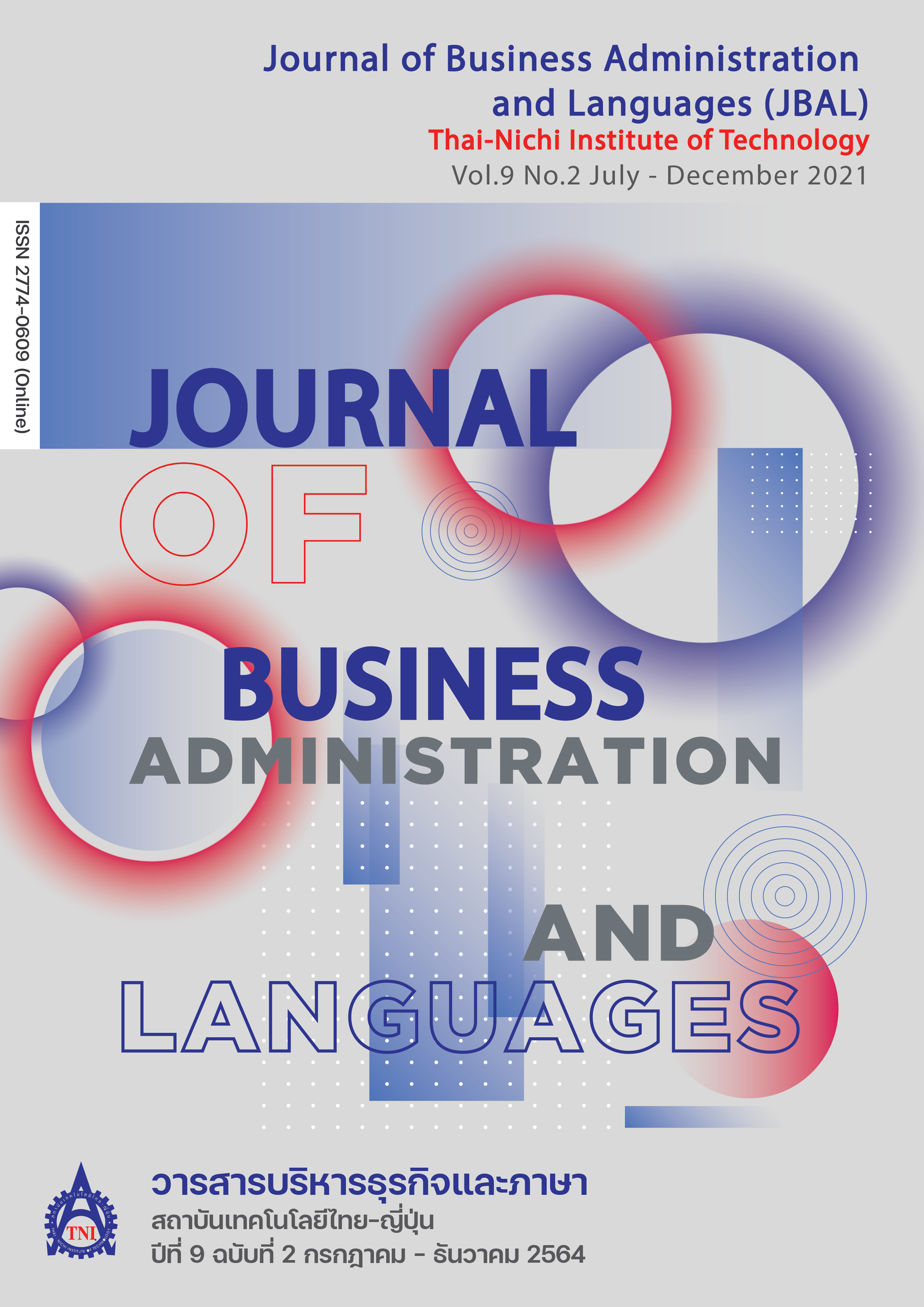Factors Influencing the Decision to Watch the Tokusatsu Kamen Rider Movies and Purchase Toys from the Movies in Thailand
Main Article Content
Abstract
The objectives of this research were (1) to study the factors that influence the decision to watch the Tokusatsu Kamen Rider movies and (2) to study the factors that influence the decision to buy toys from the Tokusatsu Kamen Rider movies. A quantitative research was applied for this research with questionnaire and collected the data from 400 people aged 14-46 who was a member of the group or followed the page in Facebook that had content about Tokusatsu Kamen Rider. The data collected were analyzed by using the percentage, mean and standard deviation. Chi-square Test was conducted to test the hypotheses. The results of study revealed that the factors that influence the decision to watch the Tokusatsu Kamen Rider movies were technique of film elements, actors of film elements, producer of film elements and distribution channel of movies at a significant level of 0.05, but story of film elements, director of film elements and marketing promotion didn’t influence the decision to watch the Tokusatsu Kamen Rider movies. The factors that influence the decision to buy toys from the Tokusatsu Kamen Rider movies were benefit of toy components, quality of toy components, marketing promotion, distribution channels and the decision to watch Kamen Rider at a significant level of 0.05, but package of toy components and price didn’t influence the decision to buy toys from the Tokusatsu Kamen Rider movies. The results of research could be applied for producing the marketing plan, business plan or feasibility study of Tokusatsu Kamen Rider in Thailand
Article Details
Article Accepting Policy
The editorial board of Thai-Nichi Institute of Technology is pleased to receive articles from lecturers and experts in the fields of business administration, languages, engineering and technology written in Thai or English. The academic work submitted for publication must not be published in any other publication before and must not be under consideration of other journal submissions. Therefore, those interested in participating in the dissemination of work and knowledge can submit their article to the editorial board for further submission to the screening committee to consider publishing in the journal. The articles that can be published include solely research articles. Interested persons can prepare their articles by reviewing recommendations for article authors.
Copyright infringement is solely the responsibility of the author(s) of the article. Articles that have been published must be screened and reviewed for quality from qualified experts approved by the editorial board.
The text that appears within each article published in this research journal is a personal opinion of each author, nothing related to Thai-Nichi Institute of Technology, and other faculty members in the institution in any way. Responsibilities and accuracy for the content of each article are owned by each author. If there is any mistake, each author will be responsible for his/her own article(s).
The editorial board reserves the right not to bring any content, views or comments of articles in the Journal of Thai-Nichi Institute of Technology to publish before receiving permission from the authorized author(s) in writing. The published work is the copyright of the Journal of Thai-Nichi Institute of Technology.
References
Bandai Namco Holdings Inc. (2020). Financial Highlights for the Fiscal Year Ending March 31, 2020. Retrieved from https://www.bandainamco.co.jp/cgi-bin/releases/index.cgi/file/view/9798?entry_id=6622
Cronbach, L. J. (1990). Essentials of Psychological Testing (5th ed.). New York, NY: Harper and Row.
Horton, D., & Wohl, R. R. (1956). Mass Communication and Para-Social Interaction Observations on Intimacy at a Distance. Psychiatry Interpersonal and Biological Processes. 19(3), 215–229. Retrieved from https://doi.org/10.1080/00332747.1956.11023049
Isotalus, P. (1995). Friendship through screen: Review of parasocial relationship. Nordicom Review, 1, 59–64.
John Nopadon Vasinsunthon & Wanichaya Nawalang. (2012). The factors influencing toy purchasing behavior of primary school students in Muang District, Chiang Mai in 2012 (in Thai). Retrieved from http://johnnopadon.blogspot.com/2012/07/blog-post.html
Kotler, P., & Armstrong, G. (2018). Principles of marketing (17th ed.). New Jersey, NJ: Pearson Education.
Naphak Jitsatikul. (2014). Media exposure, consumer behavior and merchandise in Otaku Culture. (in Thai). (Master's thesis). National Institute of Development Administration, Bangkok, Thailand.
National Statistical Office. (2019). Number of Population from Registration by Age, Sex and Province: 2019. Retrieved from http://statbbi.nso.go.th/staticreport/Page/sector/TH/report/sector_01_11101_TH_.xlsx
Parichart Sthapitanonda & Singhal, A. (1999). Cultural Shareability, Role Modelling and Para-Social Interaction in an Entertainment-Education Film: The Effects of Karate Kids on Thai Street Children. In S. Ralph, J. L. Brown, T. Lees (Eds.), Youth and Global Media (pp. 205–217). Retrieved from https://bit.ly/3y5Q8ZM
Pitak Panprem. (2007). Factors affecting the decision to watch horror movies of teenager in Bangkok. (in Thai). (Master's thesis). Thammasat University, Bangkok, Thailand.
Princhart Charungchitpracharom. (2010). Communication, parasocail interaction and pro-socail value learning in fanclub of masked rider cartoon series. (in Thai). (Master's thesis). Retrieved from http://cuir.car.chula.ac.th/bitstream/123456789/20703/1/princhart_ch.pdf
Raksarn Wiwatsinudom. (2006). Direction of domestic film industry development (research report) (in Thai) Bangkok: Chulalongkorn University. Retrieved from https://cuir.car.chula.ac.th/bitstream/123456789/7826/1/Raksarn_dir.pdf
Sirada Ketuiem. (2002). Marketing communication factors influencing Thai movie viewing behavior (in Thai) (Master's thesis). Retrieved from http://cuir.car.chula.ac.th/bitstream/123456789/10623/1/Sirada.pdf
Supat Shivapornpan. (2019, May 2). Kamen Rider, Super Sentai and Ultraman look back to the superhero in Heisei generation that step out to make new things [Blog post] (in Thai). THE STANDARD. Retrieved from https://www.blockdit.com/posts/5ccabb606706202fc8c341c8
Urapong Patkachar. (2016). Film elements and the integrated marketing factors affecting audiences behavior toward Thai romantic films (in Thai). Phranakhon Rajabhat Research Journal Humanities and Social Sciences, 11(1), 74–89. Retrieved from https://so05.tci-thaijo.org/index.php/PNRU_JHSS/article/view/45086/49835
Weerasak Kowsurat. (2014, November). Project Thai film business 2.4 ten-billion-baht industry (in Thai). Forbes Thailand. Retrieved from http://surl.li/axhta
Yamane, T. (1967). Statistics: an introductory analysis (2nd ed.). New York, NY: A Harper and Row.


